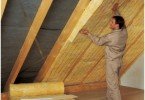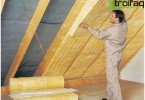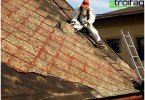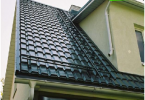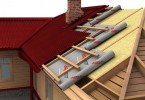We warm the attic
For a long time, people who live in harsh climatic conditions were instilled with the idea of the disadvantage of arranging an attic space for housing. But the reality today shows the very opposite picture: more and more summer residents settle in their attic, insulate it and rebuild it. Since this topic is relevant, this publication will be devoted to how to insulate the attic roof and turn a cold attic into a cozy room.
Content
- The historical roots of the attic
- Multilayer Roofing Pie
- Attic insulation materials
- Categorical “no” foam
- Mineral wool road
- Polyethylene film
- Features of polypropylene film
- Effective Diffuse Membranes
- Thermal insulation with special panels
The historical roots of the attic
The historical roots of the attic origin date back to the year 1630, when an architect from France, François Mansard, used the first pitched roof in the world for household and residential purposes. For a long time, the attics served as housing for the extremely poor, who suffered from cold and heat. And with the invention of new construction projects and technologies, people have an amazing opportunity to create comfortable conditions in the attic, regardless of the weather outside..
Multilayer Roofing Pie
Yes, that’s right, since the attic needs not only to be insulated, but to properly organize the “pie” of insulation. Properly conducted insulation of the attic just resembles a multi-layer cake.
Summer house construction is developing rapidly, with the advent of new thermal insulation materials, owners of suburban housing have increasingly begun to build attics, because they have advantages that are not subject to objection. This is not only beautiful, but also financially profitable: a similar one-story house or a full-fledged two-story house will cost a much larger amount of money. And also many people are sure that the attic brings special comfort to the house..
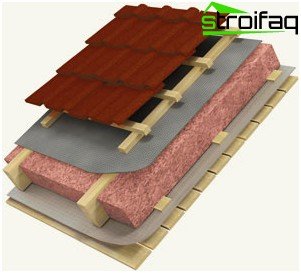
Multilayer Roofing Pie
Warming of the attic should be carried out, adhering to some features and rules in order to avoid undesirable consequences in the winter. In order to understand how to properly insulate the attic, one should recall the laws of physics: the peculiarity of the operation of the house in the winter is that the warm air stream always goes up and where it is colder. In addition, he accumulates in himself all the pairs coming from the room, that is, the breath of people, the pairs from cooking and from taking a shower. All this steam goes up and enters the roof insulation layer, where it condenses and turns into water.
Accordingly, the water in the heat-insulating material is dampness in the room, significant heat loss at home, the interior decoration that has fallen into disrepair, and the nerves of homeowners. Here, in order to avoid such a course of events, this multilayer cake is also needed. It must prevent the penetration of steam into the insulation material (vapor barrier is responsible for this), and if the steam still penetrates there, it must be removed as soon as possible (weathering through ventilation gaps). And if this condensate forms under a metal roofing, then the waterproofing layer will not let it pass into the insulation.
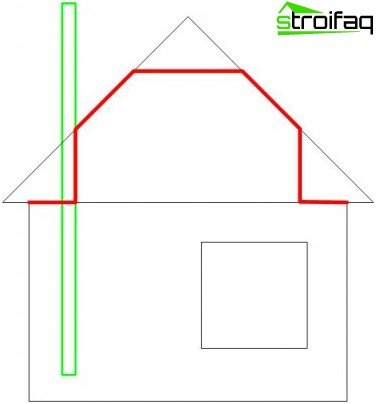
Attic thermal insulation scheme
So, we can come to logical conclusions: how to insulate the roof of the attic – vapor transmission waterproofing with ventilation gap + vapor insulation with ventilation = proper roofing “pie”.
Important: according to the recommendations of experienced builders, it is necessary to leave a small triangle in the upper part of the attic. This measure provides better ventilation..
Attic insulation materials
Each material is characterized by its own characteristics, which must be taken into account when choosing the best option. The insulation must retain its properties for a long time, be biostable, non-toxic, waterproof, not emit unpleasant odors and meet fire safety requirements.
Categorical “no” foam
Despite the good thermal conductivity and economic benefits, polystyrene can not be used for attic insulation. Such savings are not needed here, since all the components of the roof, that is, the lathing, rafters, rafters, Mauerlat and insulation must be adequately ventilated. And also the insulation must allow air and moisture to pass through. Polyfoam does not possess such characteristics, the roof will not “breathe” with it.
Mineral wool road
These heaters are best suited for attic insulation, as they do not burn, withstand high temperatures, are light in weight and have a low coefficient of thermal conductivity. They are also tough, resistant to slipping and retain their size..
The choice of insulating material depends on the distance between the rafters, their location and thickness. And also when buying a heater it is advisable to know the norms of your region and purchase a material with an appropriate heat transfer coefficient.
Polyethylene film
Such a film may be a reinforced mesh or fabric and is used as a waterproofing..
Important: this is a one-sided material, so it should be laid only on the right side so as not to get the opposite effect.
If there is high humidity in the attic, it is advisable to use a reinforced film with one side covered with foil.
Features of polypropylene film
In composition, it is very similar to the previous version, but more durable and unstable to UV radiation. If there is an unheated room under the roof, then condensate will settle on this film. The same applies to roofs covered with metal tiles and metal profiles. To balance these shortcomings, it is necessary to cover the waterproofing with viscose: it absorbs water and holds it.
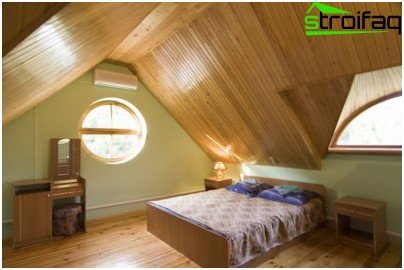
Residential attic – rational use of roof space
Effective Diffuse Membranes
This is a “breathable” material that does not allow water to pass through from the outside, but allows steam to pass from the inside. In the arrangement of the roofing “cake”, mainly three-layer diffuse membranes are used, with each layer responsible for its function: strength, resistance to UV radiation, waterproofing.
Thermal insulation with special panels
Well, if a modern material is used as a heater, in which hydroprotection is already provided, in this case one level of air circulation can be abandoned. Thermal insulation panels are placed between the rafters, while it is important not to leave gaps and to ensure their tight fit. You can also make an additional crate, for example, fill one inch board with one. When the installation of the insulation is finished, you can proceed to the finishing layer, for example, to plasterboard lining.
Attic insulation technology
The rafter system is a frame for insulation, thermal insulation material can be laid between the rafters, under them and on the rafters.
The most common option is laying between rafters. How to insulate the attic correctly, in accordance with the recommendations of experienced professionals? To do this, you must adhere to these tips:
– the insulation must always be continuous, this also applies to the areas adjacent to the wall, windows and chimneys, built into the plane of the roof;
– the width of the air gap in all areas is not less than 2 cm;
– the waterproofing material should not sag so that there is no obstacle to effective air exchange;
– if the depth of the rafters is insufficient, then they need to be increased (beat the lining of the bars or boards) or apply another option: to divide the insulation into parts: one is laid between the rafters, and the other under them.
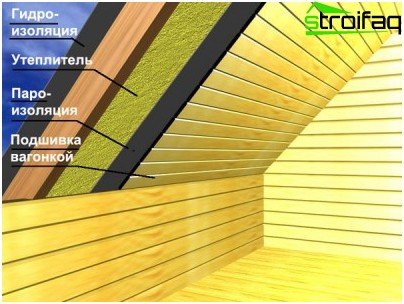
Attic roof insulation will be effective if all layers of the thermal insulation system are arranged in a clear sequence
High-quality insulation of the attic begins with a check of the health of the rafter system, if necessary, it is reorganized.
Important: this process is mandatory as wood elements can be affected by pests and insects..
If there are wormholes in the wood, then it must be treated with chemical protective agents, and badly damaged elements must be replaced.
An anti-condensation film with an overlap of 15 cm is laid along the roof slope. It is attached to the rafters with bars (thickness 4-5 cm), then the crate is attached to them. There is a gap between the film and the grill, which provides ventilation.
Is it necessary to insulate the gables?
End walls, that is, gables, also need insulation. The most effective way is the external location of the insulation. This is true if the installation of a plaster system is planned on the facade, then it is advisable to continue it on the pediments.
But this option is not always possible, so it is necessary to conduct thermal insulation in this way:
– insulation boards are installed between the bars of the frame, while remembering the layer of wind protection;
– after installation of the insulation, the entire wall is closed by vapor barrier.
Important: the vapor barrier layer on the pediment and slopes should not be interrupted.
Has the roof already received additional protection against heat loss? Remember that to create truly comfortable conditions in the attic space, you will need to insulate the walls.
Careful warming of the attics guarantees a comfortable microclimate both in hot summers and fierce winters. A properly selected thermal insulation reduces heating costs. Just a wonderful combination!


